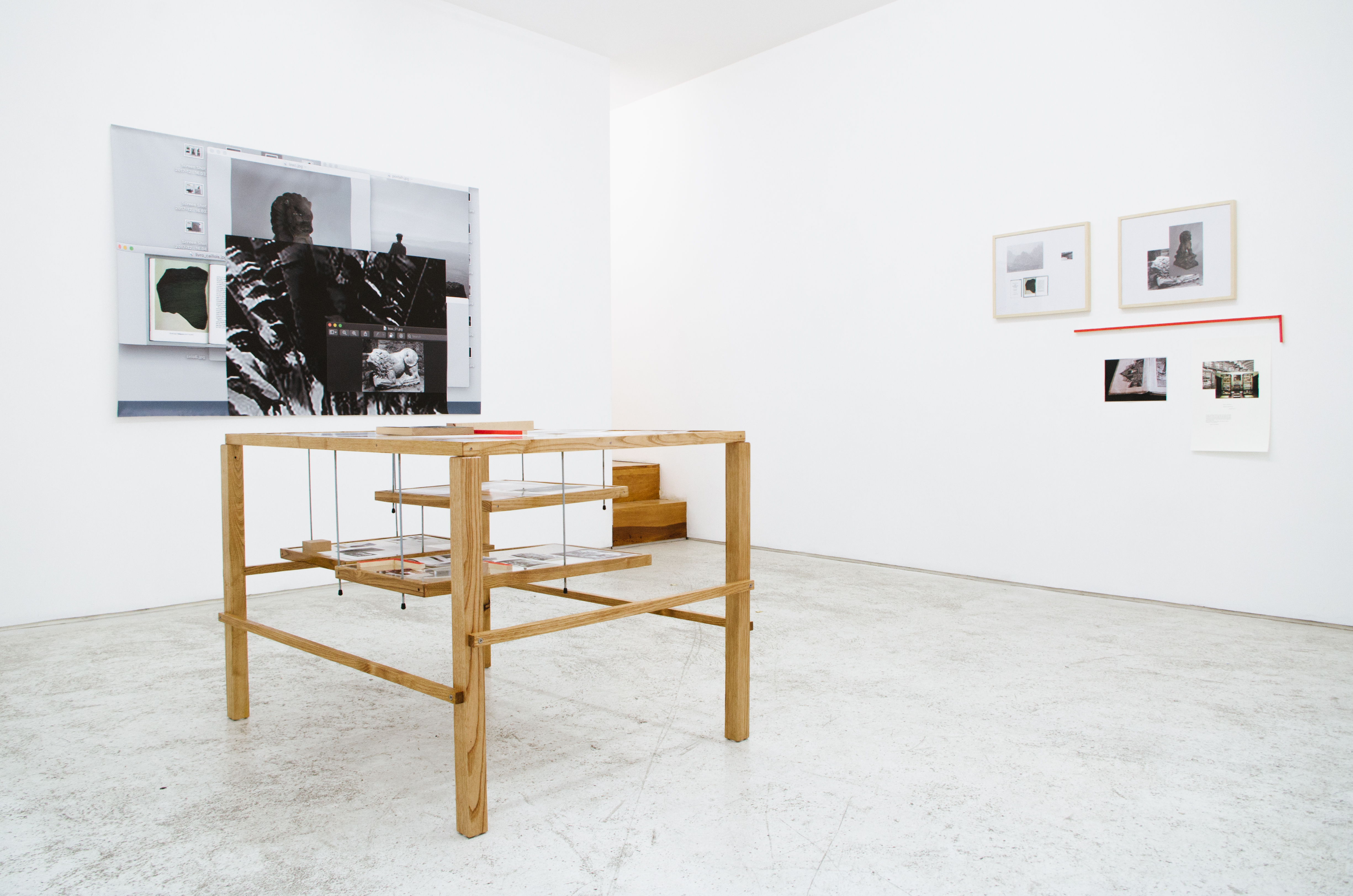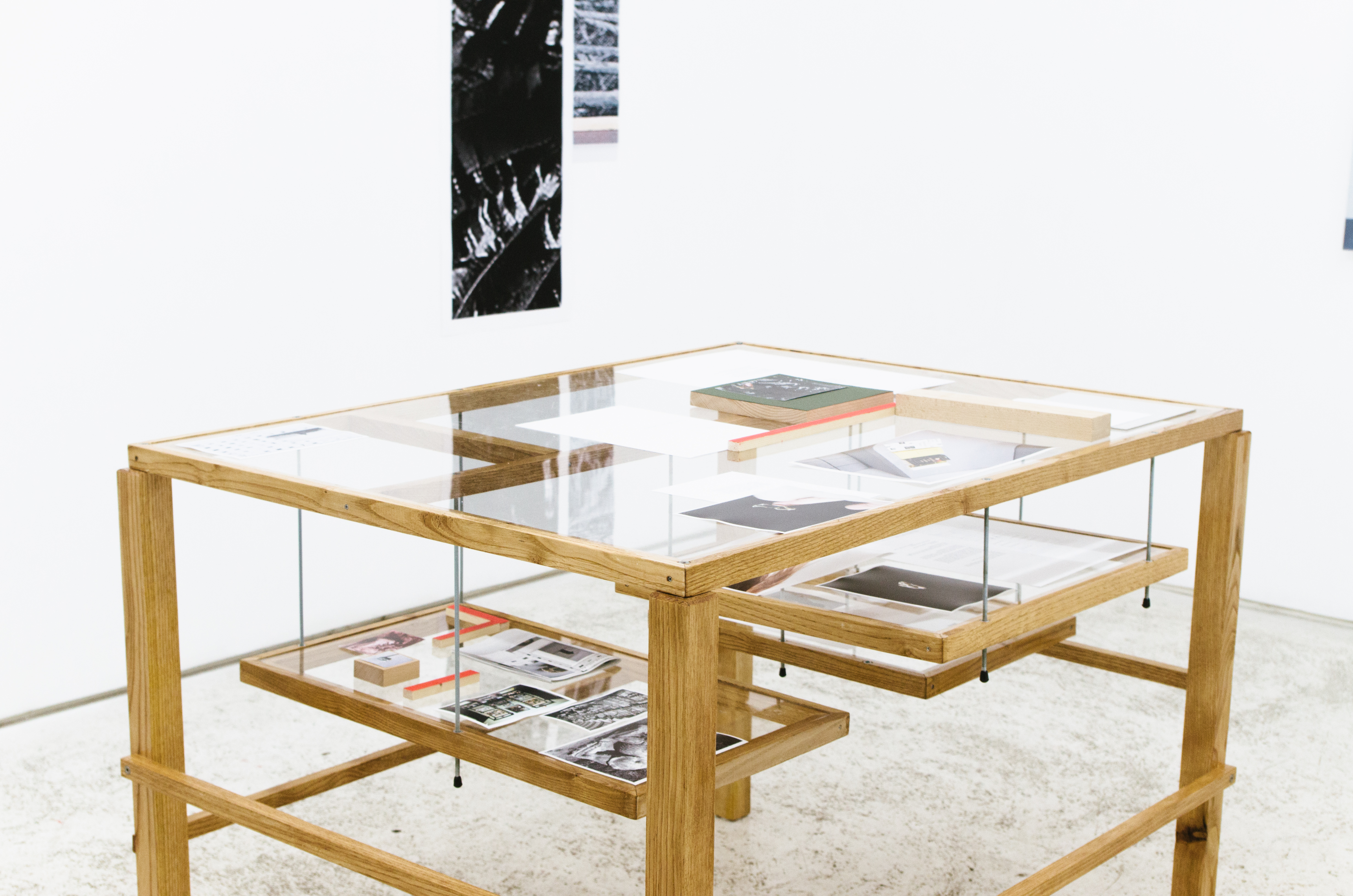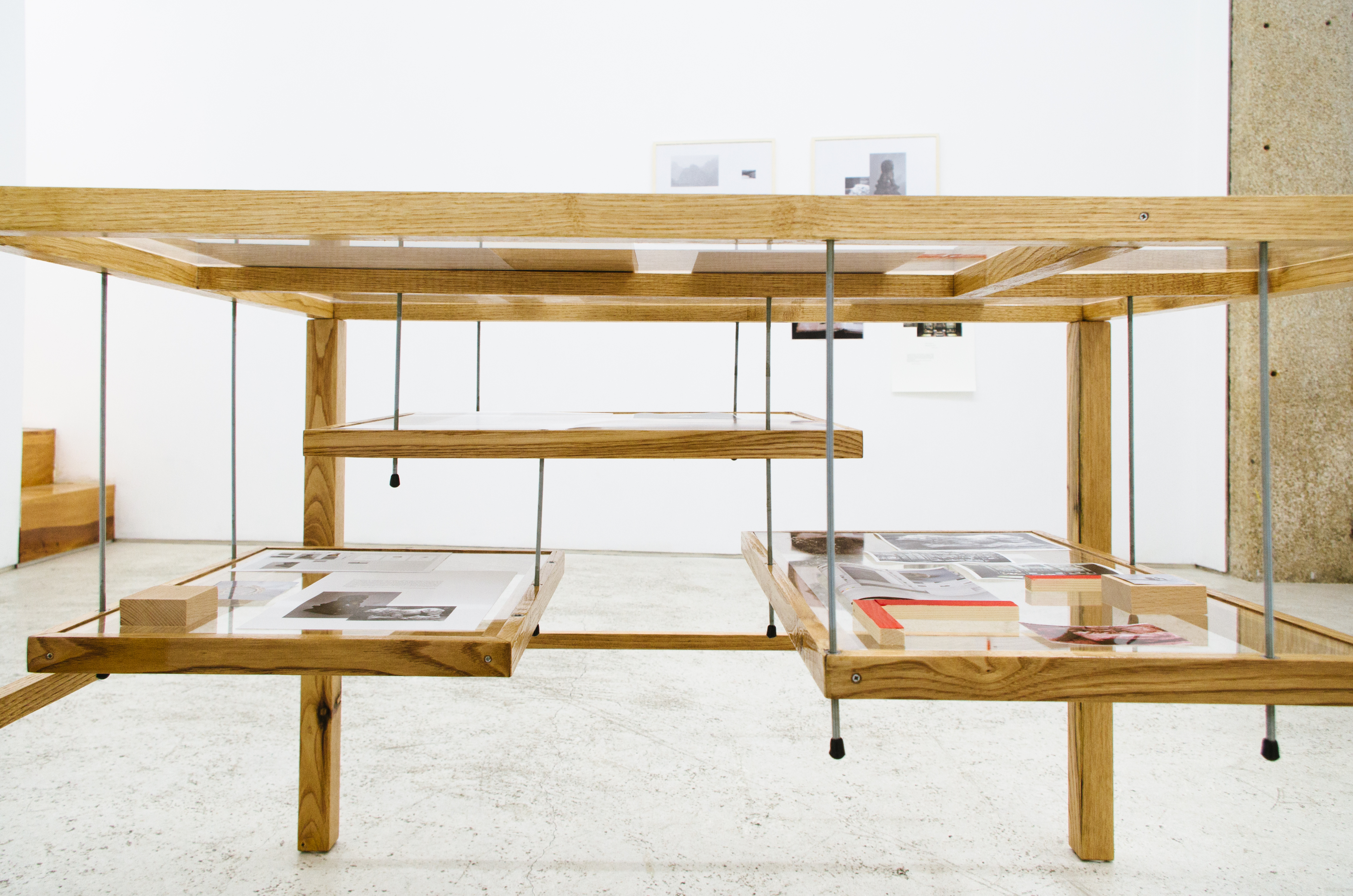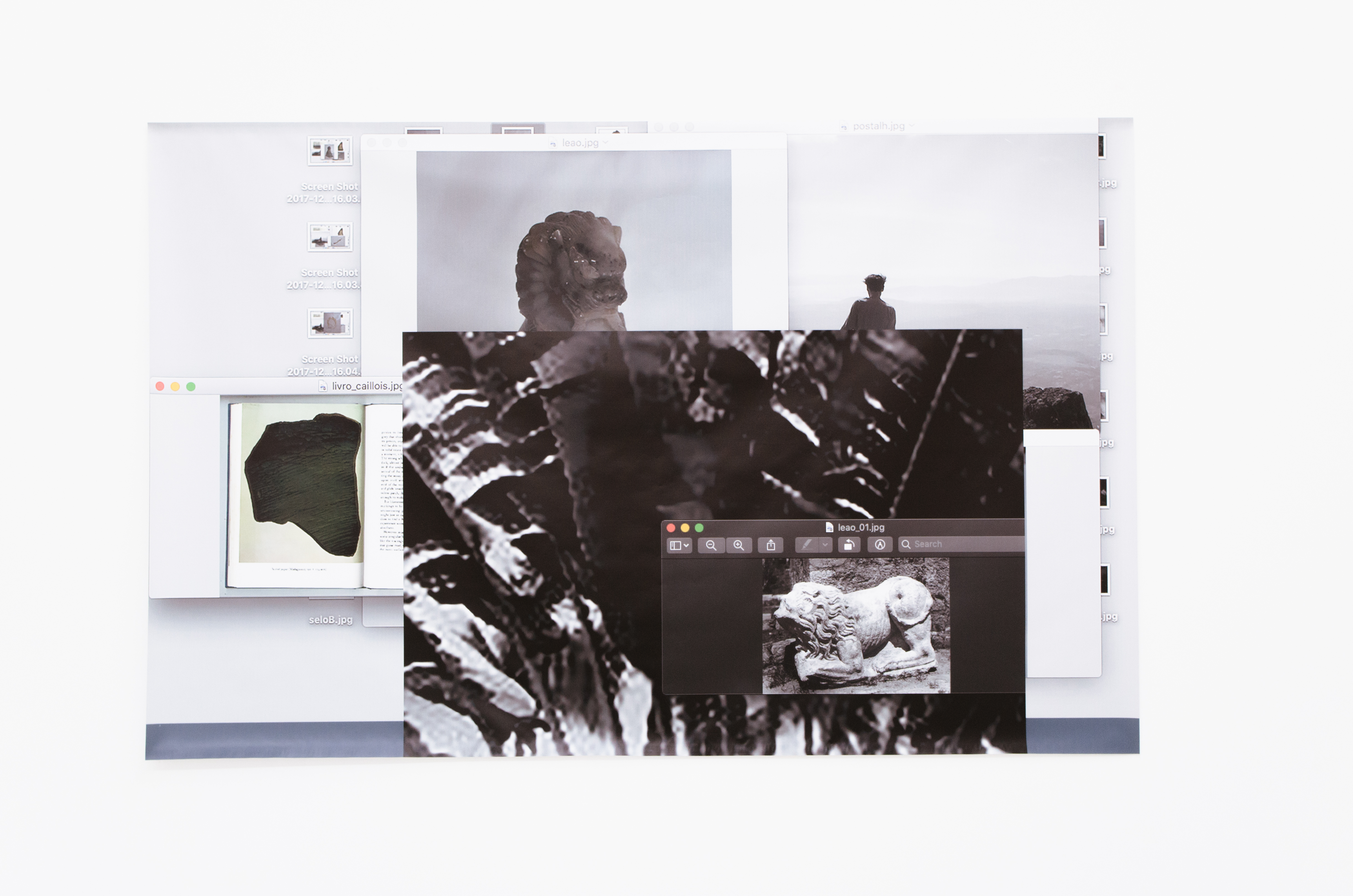How to tell the story of a gap?
KUBIKGALLERY
26. Jan 2019 - 12 Mar. 2019

photos by Constança Babo (KubikGallery)
‘To hold alternative histories is to hold alternative
knowledges.’
SMITH, L. T. apudCLAVO, M. I., LÓPEZ, O. F. (1)
How to tell the story of a gap? is developed as a second part of the project Cabinet of Constellations, nominated for the prize Novo Banco Revelação 2018 and exhibited at Serralves.
The second part of this project constitutes an approach to narratives and a fragmentary imaginary of collections of images, objects and references gathered and organized during the last year.
‘Cabinet of Constellations’ (Part I), developed between 2017 and 2018, is a project based on the exploration and research of references and narratives related with a colonial past and the storytelling in a family.
This project starts with a photograph I took to a friend in the south of Spain, in which he stands alone and is confronted with the landscape, in the horizon is possible to see the coast of North Africa. I considered this image as a metaphor to the contemplation of domination forced upon distant territories and the impact of this violent legacy.
SMITH, L. T. apudCLAVO, M. I., LÓPEZ, O. F. (1)
How to tell the story of a gap? is developed as a second part of the project Cabinet of Constellations, nominated for the prize Novo Banco Revelação 2018 and exhibited at Serralves.
The second part of this project constitutes an approach to narratives and a fragmentary imaginary of collections of images, objects and references gathered and organized during the last year.
‘Cabinet of Constellations’ (Part I), developed between 2017 and 2018, is a project based on the exploration and research of references and narratives related with a colonial past and the storytelling in a family.
This project starts with a photograph I took to a friend in the south of Spain, in which he stands alone and is confronted with the landscape, in the horizon is possible to see the coast of North Africa. I considered this image as a metaphor to the contemplation of domination forced upon distant territories and the impact of this violent legacy.
This image is linked to several objects,
references and images through a methodological approach in the attempt to
explore connections and narratives. Each montage potentiates new links, new
narratives.
The point here is not so much the historical veracity or correspondence but the narratives and storytelling empowered by this ‘reading’ and interaction and interpretation of these links, images and stories. In this sense, the way a country with a colonizing past teaches and represents history is not surprisingly, through a white occidental and patriarchal lenses. Not always we recognize this legacy that subjugated other territories to oppression and obliteration of their cultures, language and memory. It is important then, to consider the possibilities of unlearning History or considering it from a Transhistorical point of view. The practice of storytelling and exploration of narratives can be a powerful tool for understanding/reconsider history and social contexts.
The point here is not so much the historical veracity or correspondence but the narratives and storytelling empowered by this ‘reading’ and interaction and interpretation of these links, images and stories. In this sense, the way a country with a colonizing past teaches and represents history is not surprisingly, through a white occidental and patriarchal lenses. Not always we recognize this legacy that subjugated other territories to oppression and obliteration of their cultures, language and memory. It is important then, to consider the possibilities of unlearning History or considering it from a Transhistorical point of view. The practice of storytelling and exploration of narratives can be a powerful tool for understanding/reconsider history and social contexts.






‘Table for Thought: Cabinet of Constellations: How to tell the story of a gap?’; 2019; Montage table/Instalation of research elements: digital print on paper, lambda print, objects, wood pieces with red acrylic paint; 84 x 96 x 127 cm.
The family
objects displayed belong to my parents and were passed through generations, and
some of them are difficult to know what they are or the context in which they
were acquired. Were these objects bought to local artisans in colonies or in a
more complex market system to please the occidental customers taste of ‘exotic’
cultures? In which circumstances are these objects and images related? What do
they mean in a family context or in a broader context?
How to tell
the story of a gap?
The stories passed from generation to generation, together with objects and images can tell only a fraction of a story in a context that doesn’t belong to us.
What stays hidden? What is intentionally removed?
There are things that are left unsaid or unexplained.
Stories that lose a narrator. Details left behind.
Objects that lose their function. Images that do not correspond anymore.
Gaps between narratives.
The stories passed from generation to generation, together with objects and images can tell only a fraction of a story in a context that doesn’t belong to us.
What stays hidden? What is intentionally removed?
There are things that are left unsaid or unexplained.
Stories that lose a narrator. Details left behind.
Objects that lose their function. Images that do not correspond anymore.
Gaps between narratives.



‘Cabinet of Constellations: How to tell the story of a gap?’; 2019; Lecture-Perfomance with interaction of research elements articulated in the space; 10 minutes (aproximately).




‘Cabinet of Constellations: How to tell the story of a gap?’; 2019; Instalation: digital print on paper, wood frames, lambda print, digital print on canvas, wood pieces with red acrylic paint; Variable dimensions.
Curatorial
research allows experimentation of concepts and methodologies not just in the
exhibition-making process but also on the production of knowledge. In this way,
it made sense to me to present one of my readings ‘The Transhistorical Museum’ (2018), which is composed by several texts on the
concept of transhistoricity, as well as temporality, and the way some
institutions and curators approach collections, challenging the established
narratives of Western History. Considering that the conception of Museums and
collections is a Western invention based on colonial dominance, the history of
exhibitions and private collections (for example Cabinets of Curiosities) takes
on an unreal organization of its objects not understanding or considering their
histories and narratives, presenting them on an occidental and patriarchal
lenses.
In this context, this show establishes an attempt to approach material and this historical burden in an interrogative way, experimenting montages, links and fictions. The exploration of archives and material develops in a processual and performative dinamics approaching research material in a montage table specially designed for this exhibit. This table sets a ground for exploration of research material and the approach to decolonization curatorial practices, the work on archives, unlearning and deconstruction of established narratives and what is missing or erased.
In this context, this show establishes an attempt to approach material and this historical burden in an interrogative way, experimenting montages, links and fictions. The exploration of archives and material develops in a processual and performative dinamics approaching research material in a montage table specially designed for this exhibit. This table sets a ground for exploration of research material and the approach to decolonization curatorial practices, the work on archives, unlearning and deconstruction of established narratives and what is missing or erased.
In this show, it will be present a display of
research methodologies and its articulation with fragmentary narratives in
approaches to archives and how a gap and erasure dimension can potentiate
interpretations and superimpositions of narratives. The artist approaches these
themes and problematics through image installations, as well as a
performative-lecture on the fiction/ essayistic nature of this show, interviening
with the material and references.
Ana Linhares
(1) SMITH, L. T. apudCLAVO, M. I., LÓPEZ, O. F.; The Transhistorical Museum; Valiz; Amsterdam; 2018.
(1) SMITH, L. T. apudCLAVO, M. I., LÓPEZ, O. F.; The Transhistorical Museum; Valiz; Amsterdam; 2018.
Project supported by
